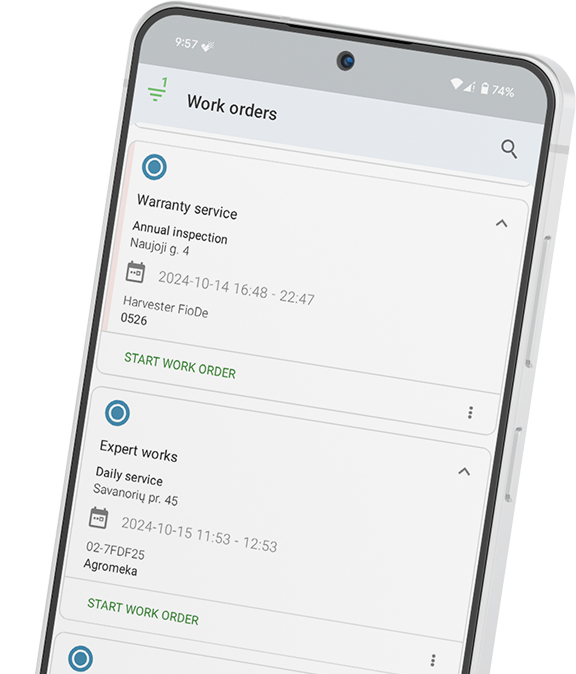Bring simplicity to your field service operations.
Our list of integrations is updated frequently. Explore each integration in its own separate page for more information.
About a month ago, we went into detail about the top 5 HVAC apps for service techs. Almost a year ago, we analysed the top 10 HVAC trends field service companies should keep an eye on. Heating, Ventilation, and Air Conditioning (HVAC) is a field service management area we care about and have a lot of experience in. HVAC technicians have traditionally carried a heavy tool bag from one site to the next in order to do their job.
Today, we’ll have a look at the comprehensive list of tools an HVAC technician needs to do their job and how it has evolved through the years.
Does HVAC software really fall under the HVAC tools category? It’s not a vacuum pump or tape measure or something you can pull out of your tool bag and fix something. Or is it?
Times have changed and HVAC software is actually the be-all and the end-all of any modern business. Software like Frontu offers companies the ability to digitally store all vital data in one place. An HVAC manager can then easily find and manage a customer’s job history, employee progress, materials, and equipment details.
More importantly, they can track the lifespan of your equipment, and. schedule maintenance. One of the most important goals of all HVAC companies is to prolong the life and usability of their equipment. To help them do that, Frontu can notify technicians when a failure occurs, and automatically designate the right team member to fix it.
Frontu is not only a task management software – it’s a one-stop shop for all operational needs. From internal communication to performance assessment, all technician and job-related layers are covered within the platform. You can assess your business performance and give technicians personalised feedback on how to get more done.
Software like Frontu is becoming a foundational, essential piece on the HVAC tools list of any modern technician. These solutions give technicians real-time access to information, task updates, customer feedback, raw material stock count, problem solutions, and suggestions. It’s the most multi-faceted, diverse HVAC tool on the market.
One of the most commonly used tools in the HVAC industry. Whether it’s used for cutting boxes, wires, or paper, a utility knife with multiple blades comes in handy on many occasions.
Usually used for hydraulic equipment, service wrenches are also used for adjusting square refrigeration valve stems, opening, and closing acetylene tanks as well as adjusting TXV superheat.
A mirror making the list of important HVAC tools? Absolutely. Technicians are often jammed into uncomfortable situations where they need to read numbers on the back of a pipe that is impossible to see. That’s when a mirror can prove to be a life-saver.
Sheet metal shears are used to cut straight lines and relatively large radius holes in metal ductwork. Large versions can cut sheet metal up to 12 gauge.
HVAC service techs need to cut copper and PVC pipes and tubes. This is a labor-intensive task that is virtually impossible without these cutters.
We would assimilate the importance of screwdrivers for HVAC technicians to what wheels mean for a car. Usually, technicians keep a multi-purpose screwdriver to turn screws with slotted heads of any size. It’s better to use an insulated handle for safety.
HVAC technicians need pliers like wire strippers and needle-nose to deal with small connections and drill holes. Again, invest in getting an insulated set of pliers for durability, safety, and longevity.
This is a no-brainer and needs no introduction. What’s important to get right is the specifics of the drill you’ll go for. It would be good to seek a 12V or higher lithium-ion battery with a 1-hour charger with a kit that includes various chucks, and drivers.
HVAC service techs often find themselves in dark places and need a reliable way to find their way and/or accurately assess air conditioning units, heating measurements, and more. This is where a flashlight comes in handy. A better alternative is headlamps, offering the same value by keeping the hands free.
Service techs need to get as far as they can, with electricity as their ally. It’s best if you go after a long, thick, insulated cord that’s easy enough to transfer. A 50-feet cord is the industry standard and covers even the most demanding projects.
The word mask has become one of the most commonly used words on the planet over the past couple of years. For the HVAC industry, is not only one of the best HVAC tools but one of the most necessary. It’s essential for technicians to protect their faces so make sure you already have spare masks in your vehicle.
Safety goggles protect your eyes from metal and dust debris. Some goggles or safety glasses with magnification also allow techs to see smaller parts of the job for better accuracy and efficiency.
Technicians work in open spaces and are exposed to loud noises that endanger their hearing. Protect your ears with industrial-strength ear muffs or plugs.
A nitrogen regulator is used as a pressure control valve, minimising highly pressurized gas or liquid into a more usable form.
Checking temperature is one of the most important areas in the HVAC industry. Every technician needs a digital thermometer that’s easy to transfer and makes their life easier.
HVAC techs usually use the awl to score sheet metal so they can cut it straight. Awls are also used to create holes in sheet metal, wood, or sheetrock. Additionally, they are used to scratch markings on sheet metal or piping.

Our list of integrations is updated frequently. Explore each integration in its own separate page for more information.

Link copied!